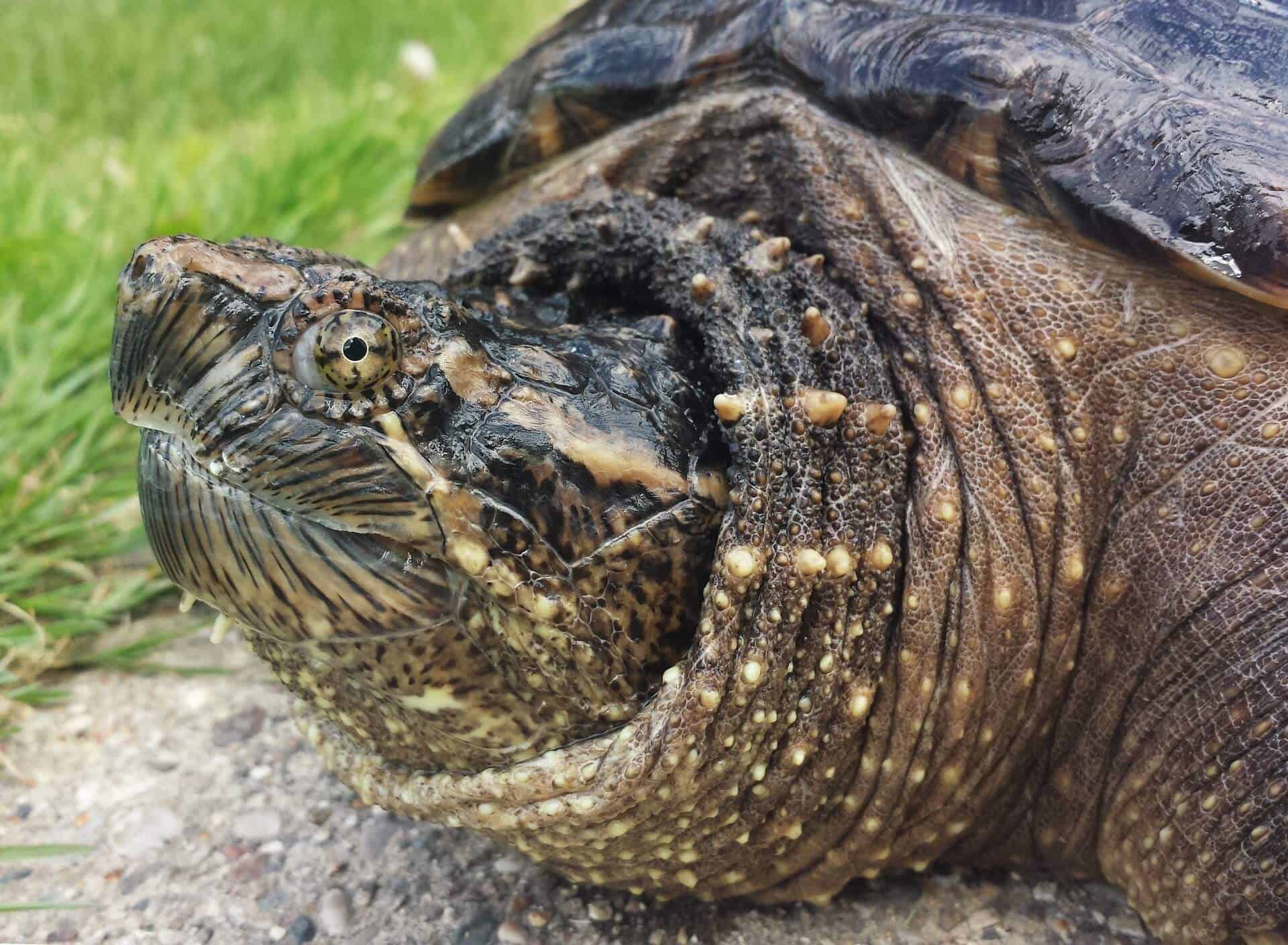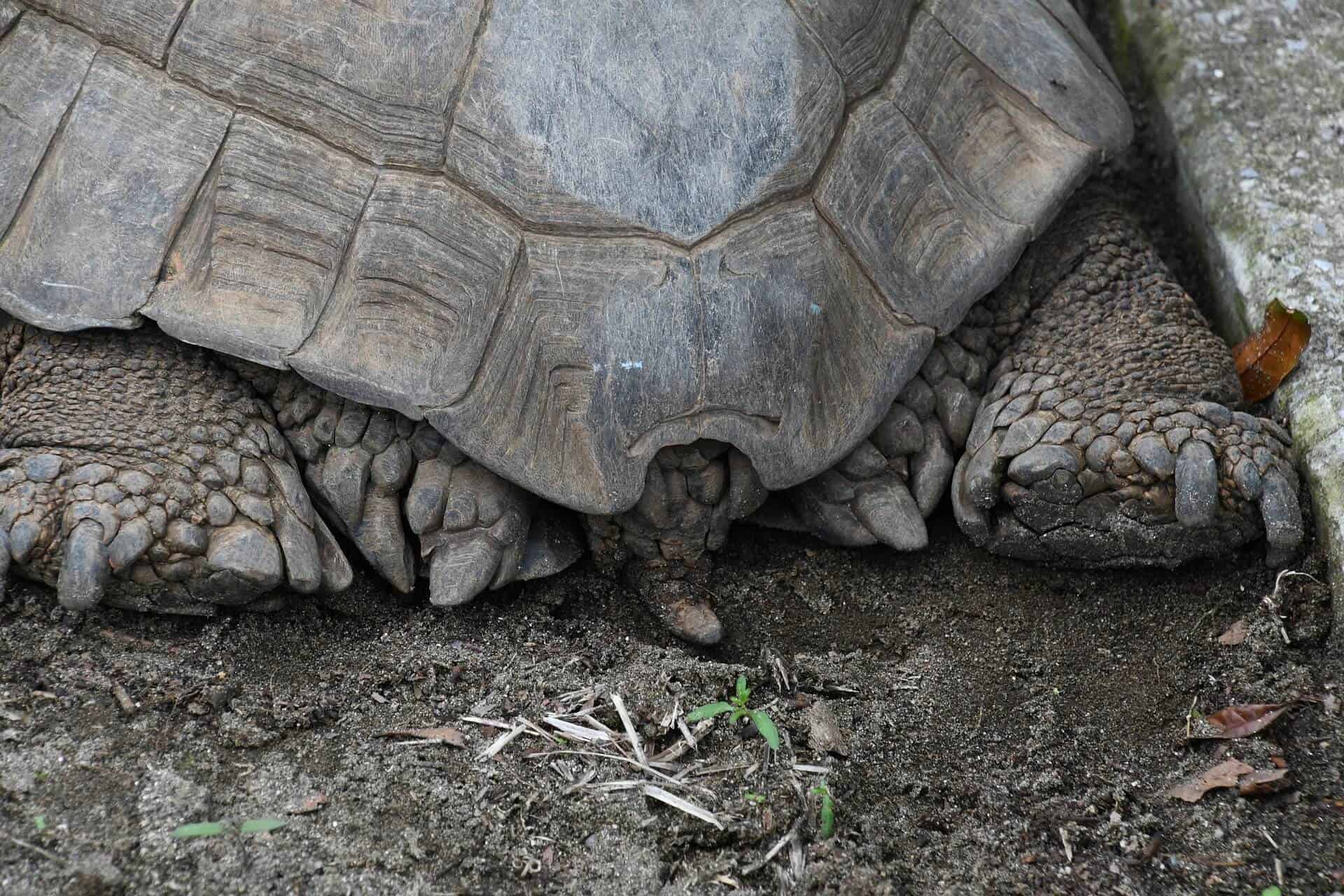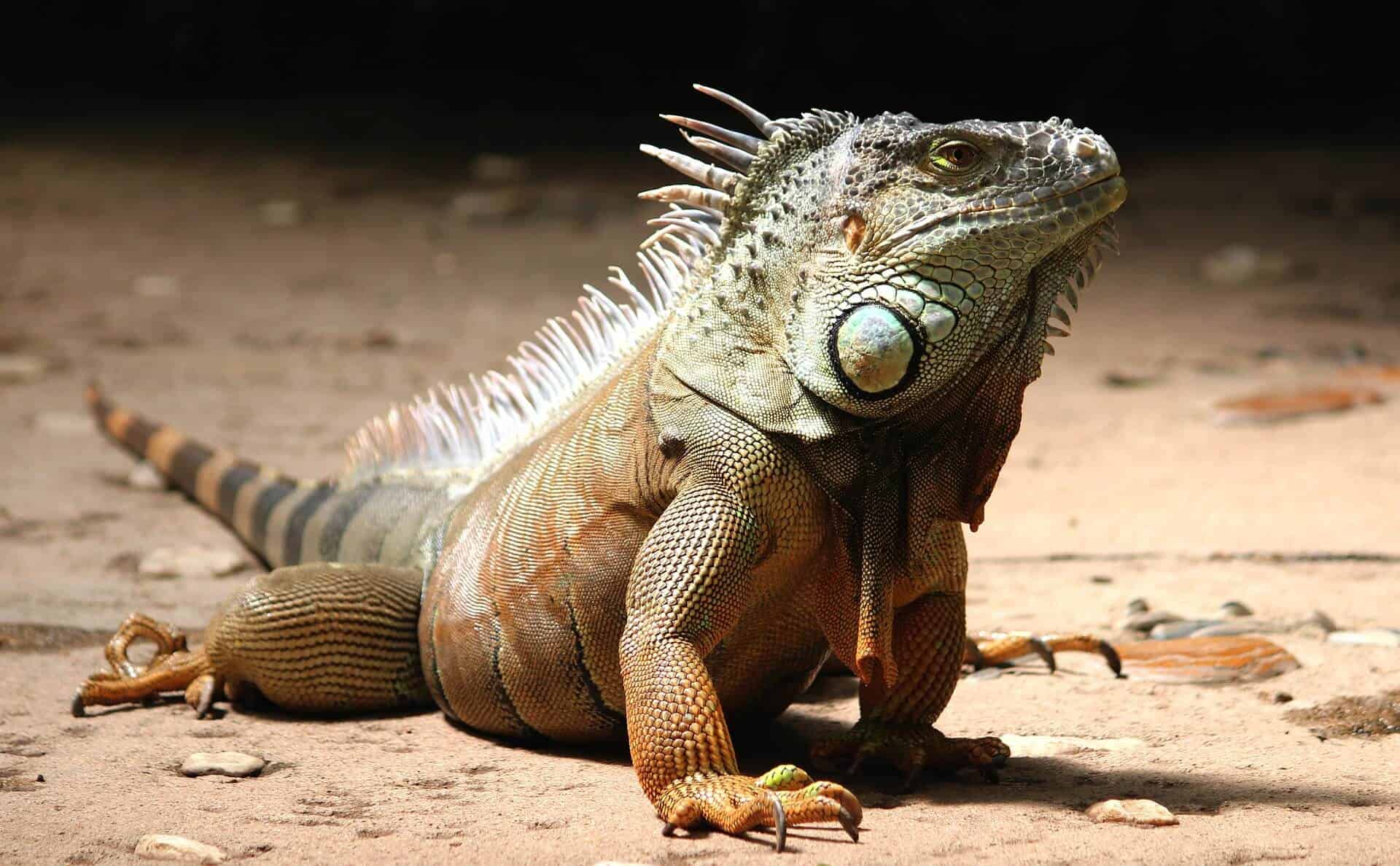Have you ever encountered a snapping turtle?
This aquatic animal is a calm turtle, found in North America. From Canada to some parts of North America, including Florida.
This guide has every piece of information on this turtle, including how it looks, its size, its habitat if it can be kept as a pet, whether it is harmful, can it bite, etc. So read on.
What Are Snapping Turtles?
Snapping turtle is also known as Tortuga Lagarto. Its scientific name is Chelydra Serpentina. It belongs to the Chelydra family, and Serpentina is Latin for the snake.
It is named so as it has a tail, and its bodily movements are that of a snake.
Thus, it is also classified in the reptile class. This is an aquatic animal that prefers shallow muddy waters for its home so it can hide.
It has a 20-inch long shell which is a brown or black color.
Snapping turtles are omnivorous animals who eat both plants and animals. Since they don’t hunt, they survive on small fishes, grass, insects, and other small animals.
They are known for their strong jaws and can stop you in your tracks if you encounter them. They look hard and can cause damage.
Types of Snapping Turtles
There are two types of snapping turtles- common snapping turtle and alligator snapping turtle.
As the name suggests, common snapping turtles are the ones that can be commonly seen across North America.
Alligator snapping turtles are one of the endangered turtle species. They are only found in a few areas and are very rare.
Physically, it is easy to differentiate between common and alligator snapping turtles.
Alligator snappers look like they are from the stone age. They have hard spikes on their backs, and their faces are also hard and look dangerous. They are also quite big when compared to common snappers.
Common snappers are black and brown-colored and have smooth shells. Their faces are also smooth, and they don’t look as dangerous as alligator snappers.
The alligator snappers weigh about 175-220 pounds. They are among the largest freshwater turtles. In comparison, common snappers are small in size and weigh only up to 35 pounds. They are only as big as a medium-sized house dog.
Alligator turtles live as long as 45 years. Common snappers live as long as 30 years in the wild while in captivity; they can live as long as 50 years.
Both live in freshwater. While males prefer to stay in the deep waters, females visit the land to make nests and lay eggs.
How Smart Are Snapping Turtles?
The entire turtle clan is counted amongst the most intelligent species on the earth. They learn and adapt very quickly.
Common snapping turtles, as they are common, have been observed, and owners report that they may be slow, but they are very intelligent. They can become friendly if they understand that you will not harm them.
They easily recognize their food cans and will react as you rattle the can. They have different personalities.
Some are very shy, while some love to explore outdoors, and if they find a water source, they will run towards it at a turtle speed. But they are sharp and fast when it comes to attacking. But they are entertaining.
Does A Snapping Turtle Have a Tail?
All the turtles have a tail. Some have a smaller one, while others have a larger one.
Snapping turtles also have a tail.
The snapping turtles are easily recognized by a carapace, i.e., upper shell, which covers their body. They also have a smaller lower shell. Thus, the snapping turtles can’t fit their entire body in their shell.
Their shell size can vary from as small as 8 inches, to as long as 30 inches. The tail is as long as the carapace or even longer than it. This tail is covered with ridges. They use it to protect themselves and use it during the mating season.
What To Do When You Find A Turtle In Your Yard?
Snapping turtles are found in North America, Canada, and the eastern and northern regions of the United States.
If you reside in the area, you may find a turtle in your backyard while taking a stroll. Normally, if you reside near a water body, it is common to witness them taking walks. The first thing you can do is to leave the turtle alone.
First, recognize if it is a snapping turtle. They vary in size. Small turtles can easily be lifted and dropped at their home. Snapping turtle has long claws and powerful limbs. It can easily injure you if you are not careful.
If you have never handled a situation before, the best thing is to call the local wildlife authorities and let them take care of it. They will trap the turtle and leave it to its natural habitat.
You can also help them by following the below steps.
- Be careful and use a box to trap them.
- Check if the turtle is healthy or if it is injured. If you are attentive, you can save a life.
- Do not hold the turtle from its front half. Their long neck is fast, and they can try to bite you.
- Do not try to pick the turtle by its tail. You may injure it.
- Nudge the turtle into the box from behind.
- You can also pick it up using its shell from the lower back. Beware of their strong hindlimbs and nails.
- If the turtle is injured, take it to the clinic immediately.
- Do not drop a turtle immediately in a water body if you don’t recognize the species. Many turtles don’t know how to swim. It may be a tortoise that spends most of its time on land.
Turtles are very peaceful animals. They don’t harm anyone unless they feel any danger. They like to live quietly under the waters.
The females visit the land to make nests and lay eggs. If they find a suitable place in your backyard and if you don’t have any problem, there is no need to remove them from your property.
They will find their own food and won’t tell a soul that they are living with you. However, you and your family can observe an important aspect of a turtle’s life as they lay eggs.
If the turtle has already laid its eggs, do not remove them. Instead, protect them.
If turtles visit your backyard in abundance, then their removal becomes necessary. But remember, they have no choice.
Their natural habitats are being destroyed, and they are compelled to wander among humans.
You have several options to remove them, but don’t get panicked. Don’t harm them, and they won’t harm you.
Can A Snapping Turtle Be Tamed? Is A Snapping Turtle A Good Pet?
Yes, a snapping turtle can be kept as a pet. However, it is a protected animal in various states. So, check the laws before getting one.
It is different from a dog or cat, and you need to have some experience keeping a turtle to give it a good life. It will take its time to trust you, but it will learn to listen to you and understand things once it does.
But keeping a snapping turtle as a pet is not something everyone can do.
First, you must be able to give it a suitable home. They are aquatic animals and spend most of their time in the water.
So, you will need a large tank for them. Or if you have a smaller water body at your premises, it will be good.
Also, they are omnivores, so your fresh farm veggies are good, but they will also need fish, insects, and worms. Not everyone is comfortable giving their pets live fish, so think before you are ready for it.
Also, if you are a person whose dogs share their beds, be ready for a very different experience with snappers. They don’t cuddle or act cute.
They grow up to be giants with long claws and teeth that can easily bite off your finger if you are not careful.
Are Snapping Turtles Illegal To Own?
Snapping turtles are of two types. Common snapping turtles and alligator snappers.
Alligator snapping turtles are listed as protected animals. Since they are rare, keeping them as pets can get you into trouble.
Six out of seven turtle species are endangered today, and thus, not every state is open about letting you keep them as pets.
In California, it is illegal to keep common snapping turtles as pets, while North Dakota and South Dakota entirely prohibit any turtle species as pets.
Do Snapping Turtles Know and Recognize Their Owners?
Yes. You may think of them as giants, but they can hear your voice and recognize you. Owners from around the globe agree that their turtles swim to the brim when called by their owners.
They also take food from your hands. Turtles are intelligent animals, and since they adapt easily, they will quickly start recognizing you if you take care of their needs.
Can You Keep Two Snapping Turtles Together?
Yes, but the advice is no. Chelydra Serpentina belongs to the large-sized turtle species. Therefore, they require a large space.
Even if you keep a single snapper, it will require a 50-gallon tank to house it properly. Imagine keeping two of them.
Yes, if you have a pond on your property, you can keep them in pairs.
Also, don’t keep snappers with any other turtle species. When snapping turtles grow up, these giants start looking at smaller species as their food, even if they are not small enough to be food.
Plus, they can be aggressive and may harm the other turtle. Don’t take risks, and keep a snapper alone in its tank.
How Fast Do Snapping Turtles Grow?
The shell grows up to 12 inches. But they take time to reach their full size. Pet owners say that Florida Snapping turtles grow larger than other species.
In the first few years, they only grow 2-3 inches. As they reach maturity, they grow 1 inch every year. Once they reach adulthood, they will stop growing.
Their total life span is 30 years in the wild, and in captivity, they live up to 50 years if they are given proper care.
How Big Can A Snapping Turtle Get?
While the common snapping turtle is the most common, it does not grow more than 14-15 inches. The alligator turtles are bigger, though.
The largest ever recorded alligator turtle was a 249 pounds alligator snapping turtle. These rare turtles can get up to 30 inches long.
Snapping Turtles Diet |What Do Snapping Turtles Eat?
Snapping turtles are omnivores. They will feed on anything they can. E.g., they will happily chew on some fresh grass and would love to munch on a live fish.
Their diet includes-
- Small fishes
- Aquatic plants
- Frogs and turtles
- Small mammals like rabbits, if they can catch them
- Birds like duck
- Insects
- Meat
- Leafy veggies
- Worms
- Crustaceans
The above list includes the food of both wild and pet turtles. If you have a pet snapping turtle, you need to give him all the necessary items, as they are crucial for its growth.
You can find some good products at the pet store.
Snapping Turtles Eggs| What Are Its Egg-Laying and Breeding Habits?
Snapping Turtles like to mate in the summer between April to November. They see each other and move their head from side to side as permission for courting.
After the two mates, the female takes the responsibility of making the nest and laying the eggs.
After insemination, the female can carry the fertile sperm inside her for around three years. So, even if she does not mate next year, she can lay eggs.
Once inseminated, she digs a nest in the sand, beaches, soil, vegetation, etc. they do it in the morning or evening to escape the eyes of the predators. The hole is 4-7 inches deep.
Turtles lay up to 40 eggs in their little hole. These soft-shelled eggs are cream-colored, the size of a ping-pong ball.
How Many Eggs Do Snapping Turtles Lay?
Generally, snapping turtles lay 20-40 eggs and even more. Turtles can lay up to 100 eggs. Once laid, they cover them back with sand and return to their home. Turtles do not sit around their babies to protect them.
The reason for laying so many eggs is that at least a few babies will survive. These eggs are very prone to predators. In fact, 80%-84% time, these eggs become the delicious dinner of predators like skunks and raccoons.
The Childhood Of Baby Snapping Turtle
The babies come out of the eggs after 75-90 days in general but may take up to 125 days sometimes. This is because they live on their own and thus are prone to attacks by predators. They are only one inch long after they come out.
They eat everything they can get, like insects, plants, fruits, etc. As they grow, they start hunting fishes, worms, small animals, spiders, worms, smaller turtles, etc.
The food for baby turtles is slightly different in the wild and as pets. If you get a baby snapping turtle, you can get them these foods. Do not catch them from your yard but instead buy them from a pet store.
The food caught from outside may be infected and can cause health problems for your baby turtle. They are not choosy when it comes to food. So, you must take great care of their food.
How aggressive and powerful are snapping turtles?
No, they are not unless they are provoked.
They are very peaceful animals and love to reside underwater, avoiding any encounters with humans. They like to live in the shallow muddy waters, and if you don’t threaten them, they won’t bite you.
If you see a snapping turtle near your pond, or roaming the area, leave it alone. They look dangerous, and they use it to their advantage. People avoid them altogether, but they are harmless.
The snapping turtles you see on the land are females who nest and lay eggs in soil and sand by digging their holes. If you bother them or their kids, they will be compelled to retaliate. They can bite, and their bite can be really harmful. So leave them alone.
Also, keep a safe distance from them. Their shell is not big enough to accommodate their entire body. They are quick, and if you approach them, they will defend, and you won’t like it.
If you are worried that you have a snapping turtle in the pond, don’t worry. They are almost invisible in water, and you won’t see them. Besides, they don’t bite once they are home and safe.
No animal is harmful unless it is hungry or angry. Snapping turtles don’t eat humans, so the best way to be safe is to not make them angry.
Are Snapping Turtles Invasive?
If you are curious whether they will occupy all your pond and won’t let other turtles survive, yes, they are invasive. They look at small animals, fishes, turtles, and frogs as their food. As they are bigger in size, they invade the place where they live.
Also, they are very adaptive. So, they are spreading in different areas of the United States. They are termed invasive, but they are not harmful.
What Damage Can Snapping Turtles Do? Can Snapping Turtles Hurt You?
You may also be wondering if the snapping turtle can bite off your finger or toe. The answer is yes, they can, but they choose not to unless you bother them. No animal is harmful unless they are threatened. If they hurt you, it’s just a self-defense mechanism.
They won’t harm you if you don’t harm them. Same for land. On land, you see females who are looking for a suitable place to lay their eggs or just going back home after making their nest. If they think their nest is in danger, they will try to bite.
They also have sharp claws, and their bite is dangerous, which is very uncommon.
Alligator snapping turtles have a great jaw strength that can bite off your finger or toe. When you look at a snapping turtle’s face, you will understand why you keep your finger away from their mouth.
Do Snapping Turtles Eat Humans?
No snapping turtles don’t eat humans. They are not choosy about their food and welcome meat and crunchy aquatic plants. So, if you are thinking, “Has anyone ever been killed by a snapping turtle,” relax.
There have been no incidents of a snapping turtle killing a human and eating it to date.
First, they are big but not big enough to kill a human. But, yes, humans have a rich history of eating turtles and turtle soup.
Can You Swim In A Pond With Snapping Turtles?
Yes. It is perfectly safe to swim in a pond with snapping turtles. These animals look for solitude and won’t come near you. They live in the deep muddy waters and are no threat to you.
What Is A Snapping Turtle’s Predator?
The baby snapping turtles have several predators. They are often preyed upon by raccoons, skunks, opossums, rats, mink, badgers, crows, fire ants, and other small animals as they get out of their shells.
They are far safer in waters as they grow up, but egrets, herons, etc., are still a problem. But adult turtles can also become prey of a bear, alligators, and even the bigger alligator snapping turtles.
Since their entire body can’t fit into the shell, they try to save themselves by attacking with their sharp claws.
What Are Snapping Turtles Good For?
Snapping turtles or any kind of turtles are good for water bodies. They eat both plants and animals, i.e., live and dead fishes, frogs, and other creatures.
So, they keep your pond clean. Without them, any water body will become a mess and stink.
How Big Is A 2-year Old Snapping Turtle?
Snapping turtles grow 3 inches in the first few years. So, a 2-year old snapper will be approx. 5-6 inches.
Can Snapping Turtles Bite Dogs?
Dogs and turtles don’t go well together. While dogs are curious animals, turtles are calm. If your dog tries to harm the turtle, the turtle will eventually react and may harm your dog.
If you have a little puppy, it’s advised to keep it away from the turtle. The turtle won’t try to eat it up, but its attack can seriously injure your furry friend.
Do Snapping Turtles Have To Be In Water?
Yes, they are aquatic animals, and they must live in water. Water is their natural habitat.
Males don’t usually leave the water; only females make a nest, lay eggs, and then return to the water. If you are getting a pet snapping turtle, make sure you can spare a large water tank for them to swim in.
How Long Can A Snapping Turtle Stay Out Of The Water?
A snapping turtle only comes out of the water to bask in the sun. At most, they can live up to 8 hours outside water.
Some turtles can go weeks and months without water, but snappers don’t.
What Happens If A Snapping Turtle Bites You?
If a snapping turtle bites you, don’t pull the finger away, or it will remove the skin and cause more damage. If the turtle is in water, let it submerge, and it will finally let you go. Its bite is not that of a little child, which hurts very much.
Turtle bite is more like a strong grip. Do not hit the turtle, or it will bite you with more force. Once the turtle knows that you don’t mean harm, it will let go.
If you have drawn blood, rush to a medical professional. Turtles carry salmonella. Thus, you may need immediate medical assistance. Antibiotics will follow.
If it is only a scratch on your skin, just wash it off properly with warm water and soap. Then apply some antiseptic, and you will be safe.
Which States Have Snapping Turtles?
Alligator snappers are rare and are only found in Florida, Texas, and Iowa.
However, common snapping turtles are found in major northeastern parts of the United States, including South Carolina and Georgia.
In Canada, they are found from Saskatchewan to Nova Scotia.
Final Words
Snapping Turtles are calm species who live their life underwater without troubling humans. Still, this species is an endangered one.
Common snapping turtles can often be seen out of water. If you see a snapper, leave it alone, and you will be safe. If it needs help, help it. But be careful. They don’t snap, but they can.





